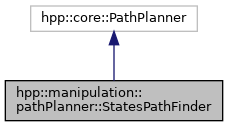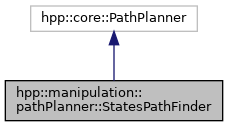#include <hpp/manipulation/path-planner/states-path-finder.hh>


Public Types | |
| enum | SolveStepStatus { VALID_SOLUTION , NO_SOLUTION , COLLISION_BEFORE , COLLISION_AFTER } |
| Status of the step to solve for a particular waypoint. More... | |
Public Member Functions | |
| virtual | ~StatesPathFinder () |
| StatesPathFinderPtr_t | copy () const |
| core::Configurations_t | computeConfigList (ConfigurationIn_t q1, ConfigurationIn_t q2) |
| std::vector< std::string > | constraintNamesFromSolverAtWaypoint (std::size_t wp) |
| std::vector< std::string > | lastBuiltTransitions () const |
| std::string | displayConfigsSolved () const |
| bool | buildOptimizationProblemFromNames (std::vector< std::string > names) |
| void | initWPRandom (std::size_t wp) |
| void | initWPNear (std::size_t wp) |
| void | initWP (std::size_t wp, ConfigurationIn_t q) |
| SolveStepStatus | solveStep (std::size_t wp) |
| void | reset () |
| virtual void | startSolve () |
| virtual void | oneStep () |
| virtual void | tryConnectInitAndGoals () |
Static Public Member Functions | |
| static StatesPathFinderPtr_t | create (const core::ProblemConstPtr_t &problem) |
| static StatesPathFinderPtr_t | createWithRoadmap (const core::ProblemConstPtr_t &problem, const core::RoadmapPtr_t &roadmap) |
Protected Member Functions | |
| StatesPathFinder (const core::ProblemConstPtr_t &problem, const core::RoadmapPtr_t &) | |
| StatesPathFinder (const StatesPathFinder &other) | |
| void | init (StatesPathFinderWkPtr_t weak) |
Detailed Description
Optimization-based path planning method.
Sketch of the method
Given two configurations \( (q_1,q_2) \), this class formulates and solves the problem as follows.
- Compute the corresponding states \( (s_1, s_2) \).
- For each path \( (e_0, ... e_n) \) of length not more than parameter "StatesPathFinder/maxDepth" between \( (s_1, s_2)\) in the constraint graph, do:
- define \( n-1 \) intermediate configuration \( p_i \),
- initialize the optimization problem, as explained below,
- solve the optimization problem, which gives \( p^*_i \),
- in case of failure, continue the loop.
Problem formulation
Find \( (p_i) \) such that:
- \( p_0 = q_1 \),
- \( p_{n+1} = q_2 \),
- \( p_i \) is in state between \( (e_{i-1}, e_i) \), (StateFunction)
- \( (p_i, p_{i+1}) \) are reachable with transition \( e_i \) (EdgeFunction).
Problem resolution
One solver (hpp::constraints::solver::BySubstitution) is created for each waypoint \(p_i\).
- method buildOptimizationProblem builds a matrix the rows of which are the parameterizable numerical constraints present in the graph, and the columns of which are the waypoints. Each value in the matrix defines the status of each constraint right hand side for this waypoint, among {absent from the solver, equal to value for previous waypoint, equal to value for start configuration, equal to value for end configuration}.
- method analyseOptimizationProblem loops over the waypoint solvers, tests what happens when solving each waypoint after initializing only the right hand sides that are equal to the initial or goal configuration, and detects if a collision is certain to block any attempts to solve the problem in the solveOptimizationProblem step.
- method solveOptimizationProblem tries to solve for each waypoint after initializing the right hand sides with the proper values, backtracking to the previous waypoint if the solving failed or a collision is detected a number of times set from the parameter "StatesPathFinder/nTriesUntilBacktrack". If too much backtracking occurs, the method can eventually return false.
- eventually method buildPath build paths between waypoints with the constraints of the transition in which the path lies.
Current status
The method has been successfully tested with romeo holding a placard and the construction set benchmarks. The result is satisfactory except between pregrasp and grasp waypoints that may be far away from each other if the transition between those state does not contain the grasp complement constraint. The same holds between placement and pre-placement.
Member Enumeration Documentation
◆ SolveStepStatus
Status of the step to solve for a particular waypoint.
Constructor & Destructor Documentation
◆ ~StatesPathFinder()
|
inlinevirtual |
◆ StatesPathFinder() [1/2]
|
protected |
◆ StatesPathFinder() [2/2]
|
protected |
Member Function Documentation
◆ buildOptimizationProblemFromNames()
| bool hpp::manipulation::pathPlanner::StatesPathFinder::buildOptimizationProblemFromNames | ( | std::vector< std::string > | names | ) |
◆ computeConfigList()
| core::Configurations_t hpp::manipulation::pathPlanner::StatesPathFinder::computeConfigList | ( | ConfigurationIn_t | q1, |
| ConfigurationIn_t | q2 | ||
| ) |
create a vector of configurations between two configurations
- Parameters
-
q1 initial configuration q2 pointer to final configuration, NULL if goal is defined as a set of constraints
- Returns
- a Configurations_t from q1 to q2 if found. An empty vector if a path could not be built.
◆ constraintNamesFromSolverAtWaypoint()
| std::vector<std::string> hpp::manipulation::pathPlanner::StatesPathFinder::constraintNamesFromSolverAtWaypoint | ( | std::size_t | wp | ) |
◆ copy()
| StatesPathFinderPtr_t hpp::manipulation::pathPlanner::StatesPathFinder::copy | ( | ) | const |
◆ create()
|
static |
◆ createWithRoadmap()
|
static |
◆ displayConfigsSolved()
| std::string hpp::manipulation::pathPlanner::StatesPathFinder::displayConfigsSolved | ( | ) | const |
◆ init()
|
inlineprotected |
◆ initWP()
| void hpp::manipulation::pathPlanner::StatesPathFinder::initWP | ( | std::size_t | wp, |
| ConfigurationIn_t | q | ||
| ) |
◆ initWPNear()
| void hpp::manipulation::pathPlanner::StatesPathFinder::initWPNear | ( | std::size_t | wp | ) |
◆ initWPRandom()
| void hpp::manipulation::pathPlanner::StatesPathFinder::initWPRandom | ( | std::size_t | wp | ) |
◆ lastBuiltTransitions()
| std::vector<std::string> hpp::manipulation::pathPlanner::StatesPathFinder::lastBuiltTransitions | ( | ) | const |
◆ oneStep()
|
virtual |
◆ reset()
| void hpp::manipulation::pathPlanner::StatesPathFinder::reset | ( | ) |
deletes from memory the latest working states list, which is used to resume finding solutions from that list in case of failure at a later step.
◆ solveStep()
| SolveStepStatus hpp::manipulation::pathPlanner::StatesPathFinder::solveStep | ( | std::size_t | wp | ) |
◆ startSolve()
|
virtual |
◆ tryConnectInitAndGoals()
|
virtual |
when both initial state is one of potential goal states, try connecting them directly
The documentation for this class was generated from the following file:
- include/hpp/manipulation/path-planner/states-path-finder.hh